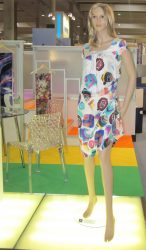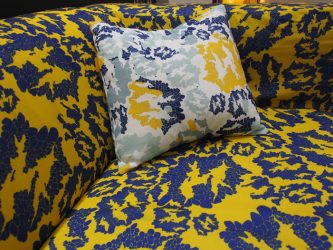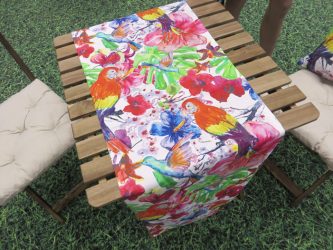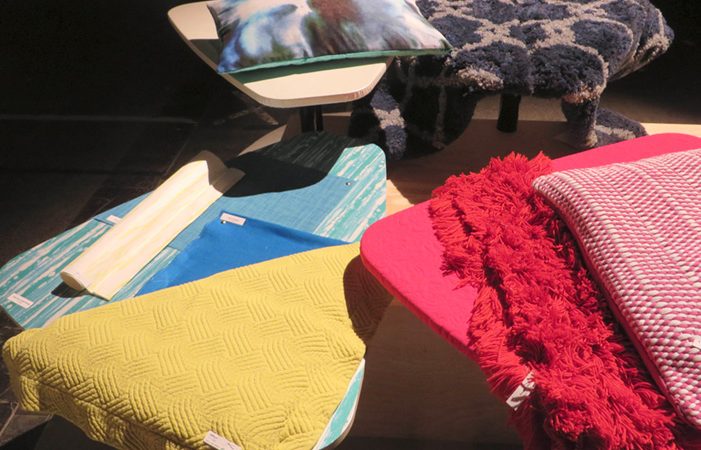Digital textile printing means you can print a dress or table-cloth with your very own design. But it is essential to look for the right ink technology.
With wide format digital technology, you can print onto just about everything – that’s why we like to call it “Wild Format”. But when it comes to textile printing for fashion or interior decoration, just a little bit more consideration and planning is required to make sure your project becomes the whopping success it deserves to be.
Paper Is Not Textile
There are two inkjet technologies most common these days: HP Latex and UV-curing inks, used in printers from leading manufacturers such as Agfa, EFI, Fujifilm, Mimaki or Roland. While both inks are common for soft signage textile printing, they were developed for advertising applications like signage, banners and flags. Occasionally at trade shows you see textile interior decoration printed with UV-curing inks. Do keep in mind, that these pieces are for show and show only, as they are neither tested nor intended for contact with human (or animal) skin. HP showcased durable textile substrates suitable for interior decoration at SGIA in 2017. After a heating process, the manufacturer claims, washability can be achieved. As a matter of fact, washability is of one of the crucial points when it comes digitally printing textile for fashion and home décor applications, as customers are not very likely to accept a T-shirt with a print that fades into nothingness after just two washing cycles in a common household washing machine. The washability problem is of course not limited to digital textile printing. Thus, in the long history of textile printing, quite a few staining options have been developed, some of them adapted for digital print, too.

Textile prints for fashion should be easy on the human skin, as well as washable
Transfer and Direct Print
The most common digital textile printing technology actually is a transfer technology. With transfer dye-sub printing the design is printed back-to-front onto very thin paper. There is also the far less common (direct) disperse dye process, where the print goes directly onto the textile. In a disperse dye printing process, the results tend to be not so very crisp, as there is some colour bleeding, leading to print-through, which is very much appreciated with flags or double-sided textiles. With sublimation printing technology, dry heat from a press or calender sublimates the ink deep into the fibres, resulting in a quite durable dye with moderate light-fastness. As only the pigments of the ink remain in the cloth, sublimation prints are considered to be kind to the skin. However, sublimation only works with a polyester (blend) or polyester coated substrate. This is why sports apparel, such as cycling shirts, are mainly decorated in a digital transfer sublimation process – Roland DG printers are very widely used in this area.
In the pioneering days of digital textile printing, primed cotton T-shirts, too have been decorated with a sublimation process. As pigment inks with binders, available both in white and process colours, have become more widely available, light and dark garments usually get printed with pigment inks. They are easy to handle, though often a pre-treatment coating and heat press finishing is required for high-quality results. Pigment inks work well with a wide range of natural and man-made fibres, so the technology became more common also for digital roll-to-roll textile printing. Pigment inks do not require a mandatory washing process and thus are considered a more planet-friendly option than traditional textile printing technologies that require a lot of water. However it is still highly recommended to wash the pigment printed new shirt before wearing it.

Cushions are a very common digital textile print application, produced in a sublimation as well as direct print processes
“Textile Textile” Printing
Water-based direct print digital textile inks come in two main flavours: Acid and Reactive inks. Vat dyes, used for cellulosic fibres have a very high outdoor light fastness and are starting to make their first steps into digital textile printing markets. As a rule, acid and reactive textile inks are traditional analogue textile printing chemistry made available for digital printing. Of course, most of advantages of digital printing remain, as no form is required. But some disadvantages of analogue textile printing are still valid, too. The “one ink fits all” concept does not apply here, as acid inks are required to print on wool, silk or Nylon. Cotton and other natural fibres stain best with reactive inks.
Steaming and washing is a mandatory finishing for acid and reactive ink prints. This process is no different to the handling of their analogue counterparts. This is why “real” or “textile textile” digital printing with traditional chemistry is often used alongside analogue printing presses in textile printing factories, eventually finally replacing their analogue predecessors. Finishing, and sometimes pre-treatment, too, requires expert knowledge, and a wide variety of costly machinery typically not found with your neighbourhood digital print service provider or sign maker. Digital roll-to-roll textile printing with traditional water-based chemistry is considered skin-friendly, there even are processes that are suitable for Oeko-Tex certification. Light-fastness can be decent, the fabrics are suitable for dry cleaning as well as machine wash, and, with the pigments transferred deep into the fibres, colours are rub resistant. Acid and reactive inks are very common with very high, very expensive digital volume production machines, for example the EFI Reggiani family. Mimaki, however, offers also wide range of versatile textile printers with different chemistry and more moderate investment levels.

With digital textile printing you can design your very own table cloth motif
Do I Need Someone from Inditex For My Textile Printing Project?
Vertically integrated fashion and home décor manufactures like Inditex (Pull & Bear, Massimo Dutti, Zara /Zara Home) have a lot of experience with digital textile printing. If you want to go into a full-blown production of fashion or home fashion, it seems reasonable to include someone with experience in that line of business into your project. With fashion, most jurisdictions require certified levels of human-ecological safety, with Standard 100 by Oeko-Tex the most common. Printed interior decoration might require a whole host of certificates, depending the country, with hazardous air pollutants and fire-retardancy for rugs, textile tapestry and curtains the most important. For smaller batches of printed shirts, caps or cushions, however, you should always be good with your trusted digital print service provider. He might even be able to point you to a knowledgeable digital textile printing expert or even factory, if you want to go really wild….
The Wild Format guides are intended to expand awareness and understanding of the craziness that can be created on wide format digital printing devices, from floors to lampshades and everything in between.
These guides are made possible by a group of manufacturers working together with Digital Dots.
This article is supported by Efi, Fujifilm, HP and Digital
Dots.
Together we hope you enjoy the articles and that you put into practice what you learn. If you want to talk about it, go to our LinkedIn group.





